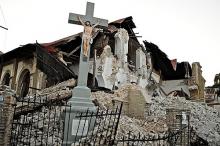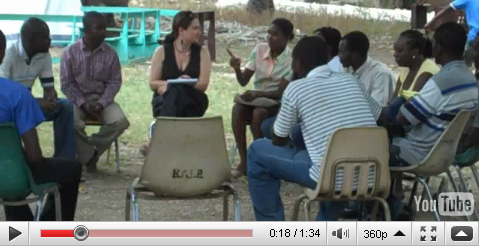Earthquake

How does one dig out from under such tragedy? How does one have hope for a better life, for a new Haiti?
In a meditation titled "The Gates of Hope," Minister Victoria Safford writes:
"Our mission is to plant ourselves at the gates of hope -- not the prudent gates of Optimism, which are somewhat narrower; nor the stalwart, boring gates of Common Sense; nor the strident gates of self-righteousness ... nor the cheerful, flimsy garden gate of 'Everything is gonna be all right,' but a very different, sometimes very lonely place, the place of truth-telling, about your own soul first of all and its condition, the place of resistance and defiance, the piece of ground from which you see the world both as it is and as it could be, as it might be, as it will be; the place from which you glimpse not only struggle, but joy in the struggle — and we stand there, beckoning and calling, telling people what we are seeing, asking people what they see."
Indeed, we need to plant ourselves at the gates of hope and work toward a just peace, on Earth as it is in heaven.
It was over in less than a minute. Three miles below the surface of the earth near a town in Virginia called Mineral, a fault line shifted. As a result, a 5.8 magnitude earthquake was felt from Georgia to New England and as far west as Detroit. The National Cathedral lost several stone spires, the Washington Monument cracked, and Sojourners' office was closed for the afternoon, as our building was checked for structural damage.
Tectonic plates move beneath our feet in the part of the globe that scientists refer to as the lithosphere. Over the course of a year, an average plate will move as little as 3 to 6 centimeters. The speed of their movement is 10,000 times slower than the hour hand on a clock and even slower than the rate of growth of human hair. For decades, sometimes centuries or millennia, a plate's movement might go almost entirely unnoticed. Then, in less than a minute, the world shakes and everything changes.
Despite the ongoing catastrophe of nuclear reactor meltdowns following last spring's earthquake, the Japanese people remain largely supportive of nuclear energy.
Evelien de Gier moved to Haiti 28 years ago from the Netherlands to work for a picture-frame production company. Her vision had three objectives. First was to create desperately needed jobs for Haitians.
The earthquake and tsunami in Japan has left many of us reeling, particularly as it came so soon after the earthquake in Christchurch, New Zealand. We are overwhelmed by the devastation and the helplessness we all feel to respond. So how do we pray for those who are suffering and for those who have died? It is not easy and anything that we can say seems inadequate. Here is what came to my mind this afternoon as I was praying for the people of Japan and remembered again those in Christchurch, and Libya, Yemen, the Ivory Coast, and the many other places of unrest in our world
A crisis of faith -- when you seriously question whether what you believe/how you see/what you're committed to is actually true -- is a good thi
Driving today through Port-au-Prince in the glaring summer sun, there is still plenty of rubble being removed. Presumably, almost seven months after the earthquake, bodies are still being discovered.
First of all, I have several pictures below I'd love to share with you from my recent trip to Haiti. It's surreal to me that a week ago, I was in Haiti -- hosted by the good folks at World Concern. The primary reason was to assess the work they've done and grasp a glimpse of the strategy ahead -- for them and other organizations.
It was just over a month ago that the earthquake devastated Haiti, an impoverished place ill equipped to deal with the disaster. Since then emergency crews, including hundreds of doctors, nurses, and first responders from the U.S. and around the world have worked with remarkable dedication and sacrifice to restore some measure of order.
